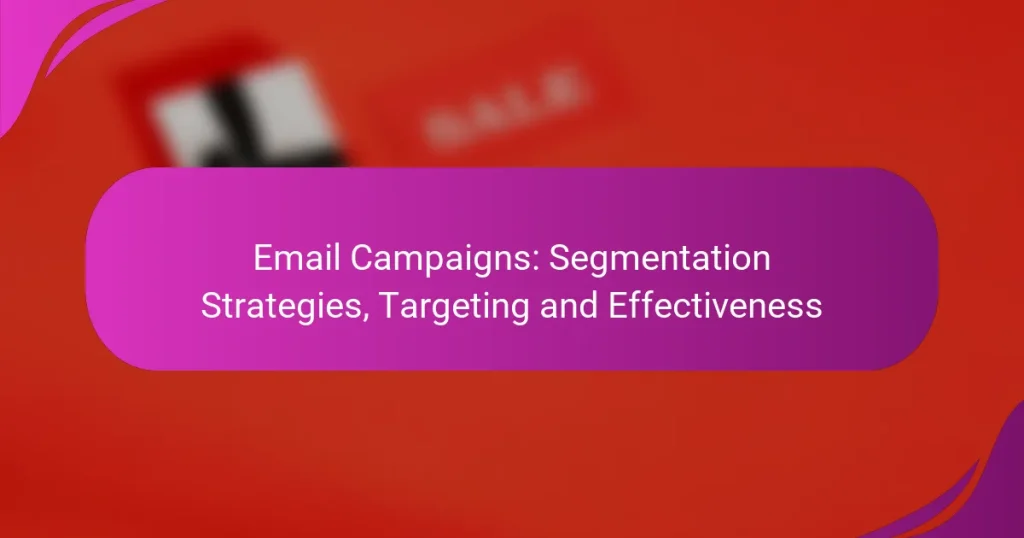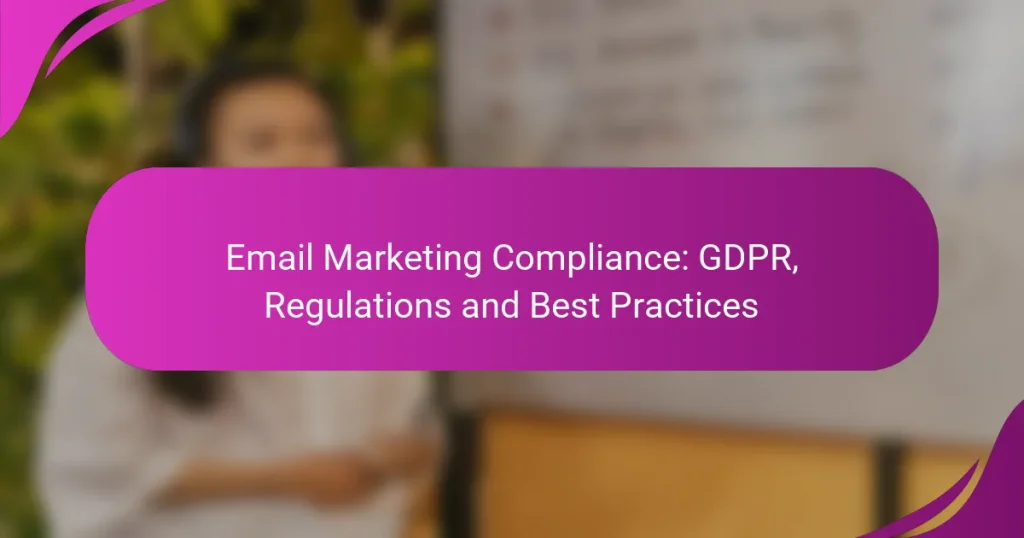Email marketing remains a powerful tool for businesses looking to connect with their audience effectively. By focusing on personalization, segmentation, and content optimization, companies can enhance engagement and drive conversions. Implementing best practices such as compelling subject lines and A/B testing can significantly improve open rates and overall campaign success.
Email Campaigns: Segmentation Strategies, Targeting and Effectiveness
Email Engagement: Personalization Techniques, Strategies and Impact
Email Marketing Compliance: GDPR, Regulations and Best Practices
What are the best email marketing strategies for South Africa?
The best email marketing strategies for South Africa focus on personalization, segmentation, automation, content optimization, and mobile-friendly designs. These strategies help businesses effectively engage their audience and improve conversion rates in a competitive market.
Personalization techniques
Personalization in email marketing involves tailoring content to individual recipients based on their preferences and behaviors. This can include using the recipient’s name in the subject line or body, recommending products based on past purchases, and sending targeted offers that align with their interests.
To implement personalization effectively, consider using dynamic content that changes based on user data. For instance, if a customer frequently buys sports gear, highlight related products in their emails. This approach can significantly enhance engagement and response rates.
Segmentation practices
Segmentation involves dividing your email list into smaller groups based on specific criteria such as demographics, purchase history, or engagement levels. This allows for more targeted messaging, which can lead to higher open and click-through rates.
In South Africa, consider segmenting your audience by region, as preferences may vary across different areas. For example, promotional offers for winter clothing may resonate more in colder regions. Regularly updating your segments based on user behavior is also crucial for maintaining relevance.
Automation tools
Email automation tools streamline the process of sending targeted messages based on user actions. These tools can trigger emails for welcome messages, abandoned cart reminders, or follow-ups after a purchase, ensuring timely communication with customers.
Popular automation platforms like Mailchimp or ActiveCampaign offer user-friendly interfaces and customizable workflows. Take advantage of these tools to save time and enhance your email marketing efficiency, while also providing a seamless experience for your subscribers.
Content optimization
Optimizing content for emails involves creating engaging and relevant material that resonates with your audience. This includes crafting compelling subject lines, using clear calls to action, and ensuring that the content aligns with the recipient’s interests.
Consider A/B testing different subject lines and content formats to determine what works best for your audience. Keep your emails concise and visually appealing, using images and bullet points to enhance readability and engagement.
Mobile-friendly designs
With a significant portion of South Africans accessing emails on mobile devices, ensuring your emails are mobile-friendly is essential. This means using responsive design that adapts to different screen sizes and optimizing loading times.
Keep your layout simple, with large buttons for calls to action and easily readable fonts. Test your emails on various devices to ensure a consistent experience, as this can greatly impact user engagement and conversion rates.
How can I improve email open rates?
Improving email open rates involves creating engaging content that captures your audience’s attention. Key strategies include crafting compelling subject lines, selecting optimal sending times, and utilizing A/B testing methods to refine your approach.
Compelling subject lines
Subject lines are the first impression your email makes, so they must be engaging and relevant. Aim for concise language, ideally under 50 characters, and consider using action-oriented words to encourage opens. Personalization, such as including the recipient’s name, can also enhance interest.
Experiment with different styles, such as questions, urgency, or humor, to see what resonates with your audience. Avoid spammy phrases like “free” or excessive punctuation, which can trigger spam filters and reduce deliverability.
Optimal sending times
Sending emails at the right time can significantly impact open rates. Research suggests that weekdays, particularly Tuesday through Thursday, often yield better results than weekends. Aim to send emails during mid-morning or early afternoon when recipients are more likely to check their inbox.
Consider your target audience’s habits and time zones. For instance, if you are targeting businesses in Europe, adjust your sending times to align with their working hours. Testing different times can help you identify the best schedule for your specific audience.
A/B testing methods
A/B testing, or split testing, allows you to compare two versions of an email to determine which performs better. This method can be applied to subject lines, content, images, and sending times. Start with a small segment of your audience to test variations before rolling out the winning version to your entire list.
When conducting A/B tests, focus on one variable at a time to accurately assess its impact. Track metrics such as open rates and click-through rates to gauge success. Regular testing can help you continuously improve your email marketing strategy and adapt to changing audience preferences.
What are the key metrics for email marketing success?
The key metrics for email marketing success include open rates, click-through rates, and conversion rates. These metrics help marketers assess the effectiveness of their campaigns and identify areas for improvement.
Open rates
Open rates measure the percentage of recipients who open an email compared to the total number of emails delivered. A typical open rate ranges from 15% to 25%, depending on the industry and audience. Higher open rates indicate effective subject lines and sender recognition.
To improve open rates, consider segmenting your audience and personalizing subject lines. Avoid spammy words and keep your subject lines concise and engaging. Regularly clean your email list to remove inactive subscribers, which can negatively impact your open rates.
Click-through rates
Click-through rates (CTR) indicate the percentage of recipients who click on one or more links within an email. A good CTR usually falls between 2% and 5%, but this can vary widely by industry. High CTRs suggest that your content is relevant and engaging to your audience.
To boost click-through rates, use clear and compelling calls to action (CTAs). Position your CTAs prominently within the email and ensure they stand out visually. A/B testing different styles and placements of CTAs can help determine what resonates best with your audience.
Conversion rates
Conversion rates reflect the percentage of recipients who complete a desired action after clicking through an email, such as making a purchase or signing up for a newsletter. Typical conversion rates range from 1% to 3%, but achieving higher rates is possible with targeted campaigns.
To enhance conversion rates, ensure that the landing page aligns with the email’s content and offers a seamless user experience. Use persuasive copy and visuals that reinforce your message. Tracking and analyzing user behavior can provide insights into optimizing your conversion strategies.
What tools can enhance email marketing in South Africa?
Several tools can significantly enhance email marketing efforts in South Africa, focusing on features that improve engagement and analytics. Popular platforms like Mailchimp, Sendinblue, and Constant Contact offer various capabilities tailored to local businesses, helping them reach their audience effectively.
Mailchimp features
Mailchimp is known for its user-friendly interface and robust automation capabilities. It allows users to create targeted email campaigns based on customer behavior and preferences, making it easier to engage specific segments of an audience.
Key features include customizable templates, A/B testing options, and detailed analytics that track open rates and click-through rates. Businesses can leverage these insights to refine their strategies and improve overall performance.
Sendinblue capabilities
Sendinblue offers a comprehensive suite of tools designed for email marketing and beyond, including SMS marketing and chat functionalities. Its email builder is intuitive, enabling users to create visually appealing campaigns without needing extensive design skills.
Additionally, Sendinblue provides advanced segmentation and personalization options, allowing businesses to tailor their messages based on user data. This can lead to higher engagement rates and better conversion outcomes.
Constant Contact advantages
Constant Contact is particularly beneficial for small to medium-sized businesses looking for straightforward email marketing solutions. It features a drag-and-drop editor that simplifies the creation of professional-looking emails.
Moreover, Constant Contact includes social media integration and event marketing tools, which can help businesses promote events or special offers effectively. Its customer support is also highly rated, providing assistance to users who may need guidance in optimizing their campaigns.
What are the legal considerations for email marketing?
Email marketing is subject to various legal considerations that ensure compliance and protect consumer rights. Key regulations include obtaining consent from recipients, providing clear opt-out options, and adhering to data protection laws.
Compliance with POPIA
The Protection of Personal Information Act (POPIA) governs how personal data is processed in South Africa. Businesses must ensure that they collect, store, and use personal information in a lawful and responsible manner.
To comply with POPIA, marketers should obtain explicit consent from individuals before sending marketing emails. This consent must be informed, meaning recipients should understand what their data will be used for and how it will be processed.
Additionally, email communications must include an easy way for recipients to opt-out of future messages. Failure to comply with POPIA can result in significant penalties, including fines and reputational damage.



